Alienware
AW2725QF:
Two-minute
review
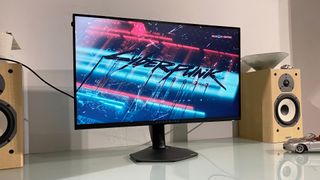
(Image
credit:
Future
/
Jeremy
Laird)
The
idea
of
using
pixel
doubling
to
turn
a
4K
monitor
into
a
native
1080p
panel
isn’t
new.
But
it
hasn’t
been
very
successful
so
far.
Can
the
new
dual-mode
Alienware
AW2725QF
do
anything
to
change
that,
or
will
it
prove
just
another
failed
attempt
at
having
both
high-res
visual
sizzle
and
high-refresh
speed
in
a
single
monitor?
Apart
from
the
dual
4K
and
1080p
modes,
this
Alienware
panel
looks
like
it
has
a
decent
shot
of
qualifying
as
one
of
the
best
gaming
monitors
out
there.
It
runs
at
up
to
360Hz
and
boasts
a
claimed
response
time
of
just
0.5ms.
That’s
seriously
fast
for
an
IPS-type
LCD
monitor.
It
also
sports
HDR
600
certification
and
both
G-Sync
and
FreeSync
support.
If
there’s
one
area
where
it’s
a
little
lacking,
it’s
connectivity.
You
do
get
a
USB
hub,
but
there’s
no
USB-C
input
for
single-cable
connectivity,
which
is
a
pity.
Alienware
AW2725QF:
Price
and
availability
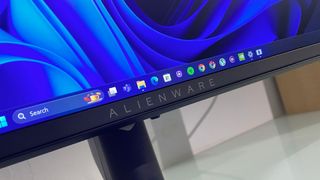
(Image
credit:
Future
/
Jeremy
Laird)
How
much
does
it
cost?
$599
/
£599
(estimated)
/
AU$899
(estimated)
When
is
it
available?
Available
now
Where
can
you
get
it?
Available
in
the
US
At
$599
in
the
US,
the
Alienware
AW2725QF
is
fairly
pricey
for
a
27-inch
4K
gaming
panel
that
lacks
a
mini-LED
full
array
backlight.
The
larger
32-inch
Gigabyte
M32UC
is
actually
cheaper.
So
you’re
really
going
to
have
to
want
that
dual-mode
functionality.
Whether
it’s
worth
the
money
is
a
tricky
call.
It
certainly
looks
a
little
better
at
1080p
than
the
dual-mode
LG
UltraGear
32GS95UE.
But
it’s
ultimately
a
bit
of
a
niche
feature.
The
good
news
is
that
purely
as
a
high-refresh
4K
panel,
the
Alienware
AW2725QF
is
an
absolute
zinger
and
nearly
worth
the
asking
price
simply
on
those
terms.
For
now,
pricing
in
the
UK
and
Australia
hasn’t
firmed
up.
But
we
expect
the
market
positioning
to
be
pretty
similar.
In
other
words,
it’ll
be
more
expensive
than
a
regular
4K
panel
of
similar
specs
minus
the
dual-more
functionality.
Alienware
AW2725QF:
Specs
to
scroll
horizontally
|
Screen size: | 27-inch |
| Resolution: |
3,840 x 2,160 |
| Brightness: |
450 nits SDR, 600 nits HDR |
|
Color coverage: |
95% DCI-P3 |
|
Response time: |
0.5ms GTG |
|
Refresh rate: |
180Hz (4K) / 360Hz (1080p) |
| HDR: |
HDR 600 |
| Features: |
Dual-mode 4K / 1080p, IPS panel, HDMI 2.1 x2, DisplayPort 1.4, USB hub with 3x USB-a and 1x USB-C |
Alienware
AW2725QF:
Design
and
features

(Image
credit:
Future
/
Jeremy
Laird)
For
a
monitor
from
an
out-and-out
gaming
brand
like
Alienware,
the
AW2725QF
is
pretty
restrained.
Yes,
there
are
a
few
RGB
flourishes
including
the
power
button
and
logos
on
the
rear
(all
fully
configurable)
and
hexagonal
base
design.
But
for
the
most
part,
it’s
pretty
businesslike
and
sober
suited,
though
the
slim
bezels
do
make
for
a
suitably
contemporary
overall
vibe.
Is
that
a
disappointment?
Might
Alienware
customers
expect
something
a
little
more
extroverted?
Possibly.
But
fussier
styling
tends
to
date
faster,
so
the
restraint
Alienware
has
shown
here
will
probably
be
welcome
for
most
users,
as
will
the
solid
build
quality
and
full
range
of
adjustment,
including
tilt,
height,
swivel
and
pivot
into
portrait
mode.
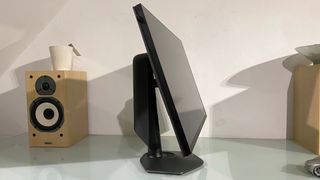
(Image
credit:
Future
/
Jeremy
Laird)
The
OSD
menu
is
similarly
comprehensive
with
settings
for
pretty
much
everything
you
need.
It’s
a
fairly
logical
menu
and
makes
it
very
easy
to
jump
between
the
4K
and
1080p
modes.
You
simply
hit
the
main
OSD
menu
selector
button
twice
to
toggle
between
the
two
modes.
Less
impressive
is
the
display’s
connectivity.
The
two
HDMI
and
single
DisplayPort
inputs
all
support
the
full
4K
at
180Hz
resolution,
which
is
good.
There’s
also
a
USB
hub
that
includes
two
USB-A
ports
at
the
rear,
plus
a
USB-A
and
a
USB-C
on
the
lower
bezel.
But
there’s
no
USB-C
input
and
thus
no
single-cable
connectivity
option
for
laptops.
Some
would
argue
that’s
fine
for
a
gaming
display.
Given
the
limitations
of
USB-C
power
supply
and
the
elevated
power
consumption
of
a
proper
gaming
laptop,
you
can’t
really
keep
one
fully
juiced
with
a
USB-C
cable.
But
it
would
still
make
this
a
more
versatile
display
to
offer
USB-C
upstream
connectivity.
With
a
USB-C
input,
you
could
share
this
panel
between
a
gaming
desktop
and
a
laptop.
And
who
knows
what
you
might
like
to
do
with
it
in
future.
With
USB-C,
you
simply
have
more
options
and
with
the
price
point
Alienware
has
gone
for,
it’s
a
thoroughly
reasonable
expectation.
The
Alienware
AW2725QF
also
lacks
an
audio
line-out
jack,
which
can
be
handy
for
headphones.
Again,
it’s
not
exactly
a
deal
breaker.
But
this
isn’t
a
cheap
display
and
it’s
the
kind
of
feature
you’d
have
thought
Alienware
would
throw
in
just
to
cover
all
the
bases
on
a
premium
monitor.
Alienware
AW2725QF:
Performance
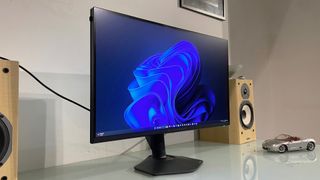
(Image
credit:
Future
/
Jeremy
Laird)
The
Alienware
AW2725QF’s
IPS
LCD
panel
makes
a
very
strong
first
impression.
It’s
extremely
bright
and
punchy,
with
up
to
450
nits
in
SDR
mode
and
600
nits
peak
for
HDR.
It’s
also
beautifully
calibrated
in
sRGB
mode,
with
rich
but
accurate
colors.
Of
course,
in
default
4K
resolution,
the
pixel
density
is
super
sharp
and
crispy,
so
fonts
look
fab.
In-game,
there’s
a
crazy
amount
of
detail
to
go
with
the
visual
sizzle.
This
is
a
very
sweet
looking
panel.
It’s
also
seriously
fast
for
an
IPS
display.
Alienware
claims
0.5ms
GTG
response
for
the
Extreme
setting
in
the
display’s
Overdrive
submenu.
That
does
bring
in
a
tiny
bit
of
overshoot
and
inverse
ghosting.
But
the
two
less
aggressive
options
are
still
very
fast
and
look
just
great.
In
fact,
this
panel
is
fast
enough
that
pure
speed
is
barely
a
concern.
Or
a
reason
to
upgrade
to
an
even
more
expensive
OLED.
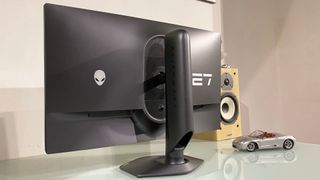
(Image
credit:
Future
/
Jeremy
Laird)
The
same
can’t
be
said
for
the
HDR
performance
and
more
broadly
contrast
and
black
levels.
This
monitor
is
edge-lit
and
does
not
have
full-array
local
dimming.
So,
there’s
plenty
of
light
bleed
and
relatively
poor
contrast,
which
goes
with
the
territory
with
any
LCD
panel
without
local
dimming.
SDR
colors
also
aren’t
terribly
well
calibrated
in
HDR
mode,
so
you’ll
want
to
switch
between
modes
depending
on
content
type,
which
is
a
bit
of
a
pain.
But
what
about
that
secondary
1080p
mode
achieved
via
pixel
doubling?
The
idea
is
that
for
some
game
types,
such
as
online
shooters,
you
want
more
speed
not
more
pixels.
So,
the
1080p
mode
offers
a
boost
up
to
360Hz
refresh
and
is
easy
to
access.
As
for
how
it
looks,
well,
it
doesn’t
quite
look
like
1080p
on
a
native
1080p
display.
It’s
certainly
better
than
the
similar
feature
on
LG‘s
own
dual-mode
4K
OLED,
the
UltraGear
32GS95UE-B.
That
might
be
thanks
to
the
conventional
RGB
subpixel
layout
of
this
IPS
display.
The
superior
pixel
density
will
help,
too.
Whatever,
the
results
on
the
desktop
are
fairly
good,
though
you
wouldn’t
confuse
it
with
true
native.
Everything
looks
just
a
little
jagged
and
pixelated.
In-game,
for
the
most
part,
the
1080p
mode
works
better
and
is
very
playable
to
the
extent
that
you
forget
it
isn’t
true
native
1080p
much
of
the
time.
The
exception
is
that
just
occasionally,
certain
details
can
look
quite
messy
and
pixelated.
One
example
is
fine
foliage
and
grass.
When
it
happens,
it
can
be
pretty
ugly.

Pixelated
in-game
foliage
on
the
AW2725QF’s
1080p
resolution
setting
(Image
credit:
Future
/
Jeremy
Laird)
In
the
end,
there
will
always
be
shortcomings
with
pixel
doubling,
but
this
display
does
it
better
than
any
yet,
including
that
LG,
which
looks
soft
and
blurry
by
comparison.
Should
I
buy
the
Alienware
AW2725QF?
to
scroll
horizontally
| Attributes | Notes | Rating |
|---|---|---|
| Value |
As a pure 4K panel, the Alienware AW2725Q is pricey. However, it’s a very nice example of the breed and if you really want the dual-mode functionality with 1080p support, it’s very appealing. |
3.5 / 5 |
| Design |
Alienware has come over all sober for this high-spec, dual-mode 27 incher. Most buyers will probably welcome that, but some will miss Alienware’s characteristic flair and design cues. |
4 / 5 |
| Performance |
As 4K IPS gaming panels go, the Alienware AW2725Q is an absolute zinger and probably the quickest display of its type. But OLED panels are quicker still and offer much better HDR. |
4.5 / 5 |
|
Average Rating |
The Alienware AW2725Q is a very sweet 27-inch 4K gaming panel. The dual-mode functionality is fun if imperfect, but the HDR performance could have you hankering for an OLED. |
4 / 5 |
Buy
it
if…
Don’t
buy
it
if…
Also
Consider
to
scroll
horizontally
|
Screen size: | 32-inch |
| Resolution: |
3,840 x 2,160 |
| Brightness: |
350 nits |
|
Color coverage: |
93% DCI-P3 |
|
Response time: |
1ms MPRT |
|
Refresh rate: | 160Hz |
| HDR: |
HDR 400 |
| Features: |
VA panel, HDMI 2.1 x2, DisplayPort 1.4, USB-C with 18W PD |
to
scroll
horizontally
|
Screen size: | 28-inch |
| Resolution: |
3,840 x 2,160 |
| Brightness: |
350 nits |
|
Color coverage: |
90% DCI-P3 |
|
Response time: |
5ms GTG |
|
Refresh rate: | 60Hz |
| HDR: | HDR10 |
| Features: |
IPS panel, HDMI 2.0 x2, DisplayPort 1.2 |
How
I
tested
the
Alienware
AW2725QF
I
rigged
up
the
Alienware
AW2725QF
as
my
primary
display
for
a
week.
The
aim
was
to
use
it
across
a
wide
range
of
applications
to
get
a
really
good
feel
for
how
it
delivers
in
both
4K
and
1080p
for
everything
from
daily
desktop
duties
to
hardcore
gaming
sessions.
As
a
4K
IPS
panel,
it’s
actually
well
suited
to
precision
productivity.
But
what
the
Alienware
AW2725QF
is
really
built
for
is
gaming,
and
for
the
most
part
it’s
pretty
stellar.
I
assed
everything
from
color
accuracy
and
response
to
latency
and
HDR
performance.
It
was
particularly
interesting
to
see
how
it
stacked
up
against
LG’s
dual-mode
OLED
display,
not
to
mention
all
the
other
recent
OLED
monitors,
numerous
examples
of
which
I’ve
reviewed.
Plenty
of
more
conventional
4K
gaming
panels
have
passed
under
my
beady
gaze,
too,
so
putting
the
Alienware
AW2725QF
into
context
was
certainly
intriguing.
First
reviewed
September
2024

